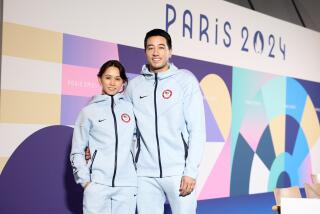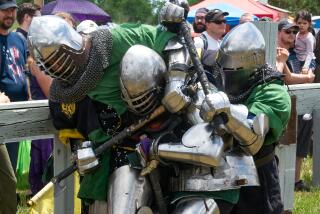Masters of the Martial Arts : Crack of Bamboo Sounds Like Music to Kendoists
- Share via
Two opponents measure each other like boxers looking to land a good punch. The silence is broken by sharp kiai screams and the cracking of bamboo sticks as the heavily protected combatants attack.
To the casual American observer, it looks like a chivalric joust between samurai warriors. But to those involved in this ancient activity called kendo, popular in Japan and Korea , physical skills are only one part of the activity.
Their objective is to get two points in the 5-minute time limit by landing a solid shot on the head, side, wrist or neck with the bamboo stick. The first combatant to land two solid shots on the opponent wins. If they are tied at zero or at one after the 5 minutes, there is a 3-minute overtime.
Landing a shot is not as easy as one would think, for it has to make a certain sound upon impact, which is left to the referee’s judgment. A point is awarded for hitting the head or hand, for example, only if a knuckle-cracking type of sound is heard upon impact and only if the kendoist keeps yelling the name of the body part he hit (like men , the Japanese word for head).
Even with that, landing a good shot to the head, side, wrist or neck encompasses a fraction of what is involved in winning a kendo match. What is considered equally important is the spiritual dimension of kendo: the impact the kiai screams really have and how you can overpower your opponent without even touching him.
Steve Kinomoto, a 16-year-old junior at North Torrance High, understands both the physical and spiritual aspects of kendo, so much so that he is one of only seven chosen for the U.S. Olympic Team that will perform in the Kendo World Championships in Seoul, South Korea, on May 28-29.
Kinomoto, whose parents are from Japan, said it took him almost 10 years to understand the spiritual aspect of kendo and how he could use it to overpower an opponent.
“You only understand the mental and spiritual part of it after a lot of years,” Kinomoto said.
Those were time-consuming years, long on dedication. Kinomoto almost quit four years ago after finding himself spending two hours a day, four days a week, practicing on technique in the dojo (practice area)--not to mention time spent studying the spiritual aspects of the sport. He’d work on fundamental techniques of the sport such as the chudon --where the stick is placed in front of your belly and facing the opponent.
Steve’s older brother, Don, also participated in kendo for a few years as a teen-ager but got tired of the sport and gave it up in favor of judo.
“The reason I got tired of it is because at that age--early teens--it was not really my choice for me to go. It was my parents’ choice,” Don said.
“My feeling is that parents--particularly Japanese parents--like to see their children get involved in this and martial arts to attain self-discipline.”
Not surprisingly, not many Americans are involved in kendo, although there are kendo dojo locations in the Midwest, Southeast, Middle Atlantic area and in Southern California. Only one of the seven U.S. National team members is not a Japanese-American. Mark Grivas, an American from New York, placed third in the Kendo world championships in 1984 in Seattle.
Steve Kinomoto, who learned the sport in the dojos, said about 98% of those involved in kendo in California are Japanese-American. Part of the reason could be the difficulty for Americans in understanding the spiritual aspect of the sport. Another is that participation is expensive: A set of protective gear costs about $1,000.
Physical abilities are simple: Quick feet, quick hands and “snappy” wrists--as Kinomoto described it--are pluses in being able to attack your opponent in kendo. But when asked to describe the spiritual aspect of the sport, Kinomoto paused and smiled at his inability to find the right words.
“A whole lot of it is spiritual,” he said. “This is hard to explain. When you compete, you have to ‘press’ with your spirit.”
The beginning of a kendo bout is a battle of will. The combatant tries to cross spiritually an invisible border of territory surrounding his opponent. For example, if in looking to attack his opponent, the kendoist got to within a foot of him, he may start to feel uncomfortable because he is starting to invade his opponent’s territory.
“If your stance is strong, your opponent has a hard time coming inside your range (that territory) to hit you,” Kinomoto said. “He feels the pressure that you’re forcing on him with your stance.”
Perhaps the simplest way to view the spiritual aspect is with the analogy of a “game face” in American sports, particularly in boxing where the two fighters stare at each other just before the opening bell in hopes of intimidating each other. Only thing is, this game face, a psychological edge one opponent could exert upon another, would play a bigger role in kendo.
A certain physical stance a kendoist takes could be intimidating because it serves as a threat as to where he will attack the opponent next. Then the kendoist would yell out the body part he will attack to further intimidate the opponent and strengthen himself.
But, as Kinomoto said, it is not quite like being psyched up as an American athlete would be for a playoff game.
“Like in football, you’re all psyched up so you can run faster. In kendo, you can use it, but only to a certain point because you always have to stay calm,” Kinomoto said. “Your emotions have to stay calm.”
In explaining this spirit, Kinomoto demonstrated how an opponent could be overpowered, taking a stance and reacting as if an invisible force was pushing him back.
“You don’t know what to do,” he said. “You feel like you’re being pressed, so you scoot back and your stance is all junked.”
“If your kiai is louder, it might overwhelm your opponent, make you seem in power and feel bigger and stronger,” he said. You use it to calm your spirit, to calm your emotions.”
When asked to explain the spiritual aspect of kendo even Masashi Shikai, coach of the U.S. National team, was unable to give an immediate response.
“Ah,” he said with a smile during a practice with the U.S. National team recently in Norwalk. “Oh, gee. . . . Kendo means ‘way of the sword.’ That means ‘way of the spirit.’ I don’t know if that makes sense. The more training you put in, the better you are able to understand the relationship between the sword and spirit.”
How about trying to explain all of this to an American 16-year-old? Not surprisingly, Kinomoto said his friends don’t see kendo as he sees it.
“They know of the sport but they don’t really understand it,” he said. “They just think you’re hitting each other with sticks.”
It can look pretty interesting nonetheless to one viewing it for the first time. That’s how Kinomoto said it was when at age 5 he went to his brother’s practices. Upon viewing this intriguing activity, the little boy told himself he was going to try kendo when he got big enough. He picked up a kendo bamboo stick two years later and stuck with the sport.
As members of the U.S. National team, Kinomoto and Grivas may be performing in front of crowds of 1,000 people in Seoul. A pretty big transition from the crowds of 100 to 150 Kinomoto faced in local tournaments. Kinomoto said he gets nervous, just like athletes would in American sports.
But, as Masashi said, the emphasis on winning is not as strong.
More to Read
Go beyond the scoreboard
Get the latest on L.A.'s teams in the daily Sports Report newsletter.
You may occasionally receive promotional content from the Los Angeles Times.










